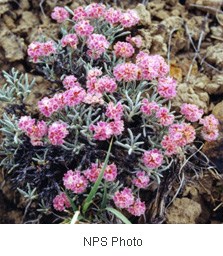
Eriogonum bicolor Family: Polygonaceae (Buckwheat Family) Subshrubs; 0.8” to 3.2” (2 to 8 cm) tall Leaves: alternate and basal; simple; 0.2” to 0.6” (5 to 15 mm) long, 0.04” to 0.12” (1 to 3 mm) wide; woolly with hairs Flowers: 0 petals; 3-6 sepals, usually 5 or 3+3, petaloid; 2-9 stamens in 2 series; 1 pistil; small flowers in clusters; flowers white to pink or rose; flowers 0.08” to 0.16” (2 to 4 mm) long Pollinators: other Eriogonum species are pollinated by bees Fruits: achene Blooms in Arches National Park: late April, May, June Habitat in Arches National Park: desert shrub, pinyon-juniper and grassland communities; often in sand Location seen: Windows primitive trail, Salt Valley Other: The genus name, “Eriogonum”, means “woolly knee” and refers to the hairs located at the swollen joints of many species of this genus. The species name, “bicolor ”, means “of two colors”. This plant is endemic to Carbon, Emery, Garfield, Grand (the type specimen was collected in Thompson Springs), San Juan, Sevier, and Wayne Counties in Utah. This family's scientific name, “Polygonaceae”, is derived from the Greek words “poly” which means "many" and "goni" which means "joint", a reference to many species that have swollen nodes or joints. |
Last updated: April 29, 2025
